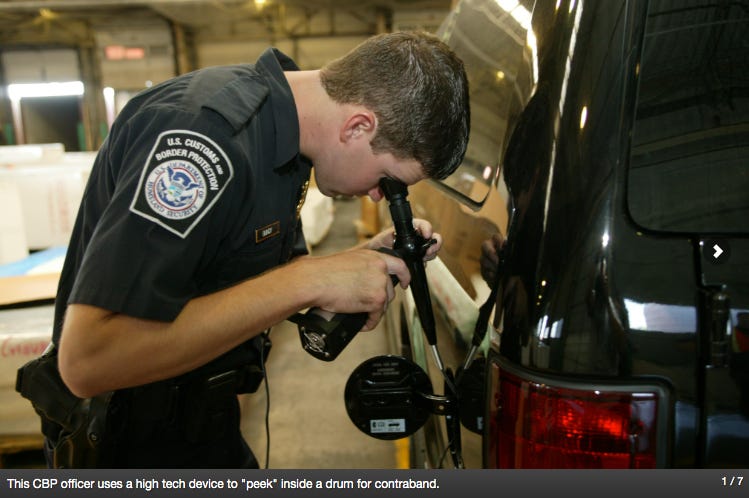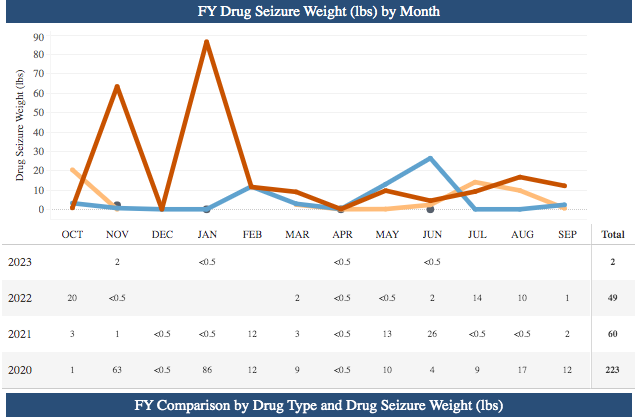The Daily Agenda: Stop looking in the wrong place
We have to deal with fentanyl … So let’s deal with it where it is, not where it isn’t … New rules at Tucson High.
The amount of drugs smuggled through Arizona’s desert today has gotten so small it would’ve been a rounding error a decade ago.
It’s a fact the public, and elected officials, need to understand if they are going to deal with fentanyl, a synthetic opioid that causes tens of thousands of deaths every year, including 222 in Pima County so far this year.
Local officials launched a massive campaign this month to deal with fentanyl in Tucson and Pima County. Education is a big part of that effort, such as talking to doctors about when they should prescribe opioids, explaining the risks to fentanyl users, and removing the social stigma of opioid use.
We need another education campaign to go along with the local one, this time about how fentanyl enters the country and arrives in Pima County.
Fentanyl smuggling is widely misunderstood, even in Southern Arizona, one of the main places where fentanyl enters the country. And federal officials, especially border hawks, keep beating a drum that’s leading the public toward the desert, instead of toward the ports of entry where the vast majority of fentanyl is smuggled across the border.
Curt covered the border for about a decade, including several years at the Arizona Daily Star. He’s read thousands of border-related cases in Tucson’s federal court and spoken with more officials, lawyers, Border Patrol agents, customs officers, and border residents than he can count.
So here’s the quick-and-dirty version of how fentanyl first came on the scene and how smuggling fentanyl works today.
First, you have to think about marijuana. Border Patrol agents used to seize well over 1 million pounds of marijuana every year in Arizona’s desert, mountains, and highways.
It was a multi-billion dollar business that gradually evaporated as dozens of states, including Arizona, legalized marijuana. Instead of sketchy arrangements with local dealers, marijuana aficionados could walk into a store, speak with a friendly budtender behind a counter, and walk out without having committed any crimes. Sales in Arizona now surpass $1 billion annually.
That took its toll on marijuana smuggling. Instead of a million-plus pounds, Border Patrol agents in Arizona seized just 2,700 pounds in the fiscal year that ended in September.
The cash flow that criminal organizations in Mexico depended on to buy pistols, sniper rifles, body armor, and grenade launchers in the United States was disappearing.
But as marijuana smuggling faded over the past decade, fentanyl came on the scene. The opioid epidemic was sweeping across the country and OxyContin users who lost access to pills were shifting to heroin, and then the much cheaper fentanyl.
Companies in China manufactured the ingredients and shipped them to Mexico, often using seaports on Mexico’s western coast. Criminal groups in Mexico synthesized fentanyl in labs and then moved it to the border.
Although fentanyl replaced marijuana as a revenue source, it didn’t follow the same routes across the border as marijuana. Instead, smugglers used the routes they built up for heroin.
Those routes run through ports of entry, not through the desert.
Smuggling organizations pay people, often U.S. citizens who may face less scrutiny from customs officers, to hide packages of fentanyl in their cars as they drive through ports of entry or strap it under their clothes as they walk through the pedestrian lanes. Those short trips across the border are tightly scheduled and watched by the smuggling organization, just like they do with heroin, cocaine, and meth.
From the smuggler’s perspective, the advantage of using ports is how busy they are. Customs officers deal with an enormous amount of legal traffic as people cross the border to work, shop, visit friends, or a variety of other reasons. Those crossings came to 24 million in Arizona this year, which we talked about last week.
For the first few years of the fentanyl era, smugglers used ports of entry near San Diego almost exclusively. But over the last two years, they started to move more fentanyl through ports in Arizona.
This is where we are today. Smugglers replaced marijuana with fentanyl and now they’re moving huge amounts of fentanyl through ports of entry, almost entirely in Arizona and California.
Here’s how it looks by the numbers:
Federal officials seized 27,000 pounds of fentanyl in the fiscal year that ended in September. That’s up from 14,700 the previous fiscal year.
Nearly 90% was seized at ports of entry, including 12,000 pounds in Arizona and 11,400 pounds in California.
About 10% was seized by Border Patrol agents in the deserts, mountains, and highways, including 1,400 pounds in Arizona and another 1,400 pounds in California. Tucson Sector Chief John Modlin told Congress in February that about half of the 700 pounds of fentanyl seized by Tucson Sector agents in fiscal 2022 came from smugglers hauling it through the desert.
Just 2% of all fentanyl seizures were along Texas’s 1,200-mile border with Mexico.
This is what elected officials need to understand. They need to look where fentanyl is smuggled across the border. They need to look at ports of entry, not out in the desert.
Fentanyl is undoubtedly a hot political issue today. When new House Speaker Mike Johnson said Congress would take action on fentanyl and the border, he got a 14-second standing ovation from his Republican colleagues.
By this time next year, you can bet fentanyl will be an even bigger issue. Voters will be casting their ballots after months of former President Donald Trump, Senate candidate Kari Lake, and their ilk hammering President Biden over the rise in fentanyl smuggling and the ensuing overdose deaths.
If officials invest in more screening technology and drug-sniffing dogs at the ports of entry in Arizona and California, they’ll have a much better shot at making a dent in fentanyl smuggling.
There’s good news on that front. Over the past few years, federal officials set in motion large-scale modernization projects at ports of entry in San Luis and Douglas.
But if officials keep directing the public’s attention to the desert, that’s where the public will think the problem is. And that’s where the public will support spending millions, if not billions, of tax dollars.
Meanwhile, smugglers will just keep using ports of entry.
Surge in arrivals: Violence due to an armed conflict between warring criminal groups in Sonora has led to an influx of migrants crossing the U.S.-Mexico border onto Tohono O’odham Nation land over the past few days, the Arizona Daily Star’s Emily Bregel reports. Tribal officials say the more than 2,500 migrants apprehended since Saturday is a volume that’s extremely rare in the region. Most of the migrants were asylum seekers brought in by smugglers who were pushed further west than usual, after U.S. construction teams sealed previously open gaps in the border wall near Sasabe.
Don’t trash that gourd: The University of Arizona’s Compost Cats program is collecting post-Halloween pumpkins to cut down on methane emissions that rotting gourds produce in a landfill, the Arizona Luminaria’s Teressa Enriquez reports. In the past three years, Compost Cats have diverted more than 45,000 pounds of food scraps from landfills. The group is offering two drop-off locations for pumpkins, which will be accepted carved or whole. Painted pumpkins will not be accepted, since the chemicals can taint the compost.
Taking action: TUSD officials have agreed to implement a list of 12 demands made by a Tucson High staffer, following a September 13 fight on campus that left an employee injured and led to the arrest of six students, KVOA’s Megan Spector reports. The demands include a smaller monitor-to-student ratio, new procedures for lockdowns, clear communication and mandatory training.
Honoring the dead: Tucson’s All Souls Procession returns for a 34th year this weekend, This is Tucson’s Elvia Verdugo writes. The procession starts at 6 p.m. Sunday, with a different procession route than previous years. The new route goes south on Grande Avenue until reaching Congress Street. After walking east on Congress, the procession will turn south onto Avenida del Convento and head to the MSA Annex, where it will conclude. Participants can begin gathering at 4 p.m. near the starting point and there are plenty of spots along the route for spectators to watch the procession.
Say “yes” to incorporation: The Tucson Metro Chamber has endorsed the proposed Vail incorporation, Inside Tucson Business reports. The chamber says that now is the right time for residents to have greater local control over decisions related to zoning, land use, public safety, recreation and transportation needs and requirements. The incorporation of Vail will result in an estimated $10 million annually allocated to the new town.
“This proposition ladders up to our public policy agenda priorities around land use, transportation infrastructure and economic development,” said chamber President and CEO Michael Guymon.
Leading the pack: The University of Arizona has been recognized for a third year in a row as a Fulbright Hispanic Serving Institute leader, Arizona Public Media’s Carly Siegel writes. The UA is one of 21 HSIs in Arizona, with more than 25% of undergraduate students identifying as Hispanic. In 2022-23, the UA set a record with 17 fellowships awarded to faculty members.
2: The pounds of heroin seized by Border Patrol agents in the desert, mountains, and highways in Arizona in fiscal 2023.













Outstanding, informative piece!